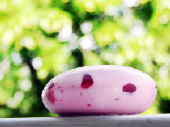
Purpose
To have some fun while demonstrate how the heating of water inside a bar of Ivory Soap can cause a chemical reaction that results in the expansion of the soap.
Additional information
The Ivory soap bar is whipped with air during its production, which is why it floats in water (and was part of their marketing gimmick back in 1891). In fact, one of the first marketing slogans used for Ivory soap was "It Floats". In addition to air, Ivory soap is composed of sodium tallowate, sodium cocoate or sodium palm kernelate, water, sodium chloride, sodium silicate, magnesium sulfate, and fragrance.
This experiment is more about fun than science. You'll see how the air pockets within Ivory soap can result in some very unusual and interesting effects when water trapped within it is heated. A word of warning though. This experiment can get a little messy and requires adult supervision at all times.
Sponsored Links
Required materials
- Bar of Ivory brand soap (other soaps won't work for this experiment)
- Paper towel
- Bowl
- Water
- Microwave-safe plate
- Microwave
Estimated Experiment Time
About 10 minutes (although cleanup may add another 10 minutes)
Step-By-Step Procedure
- 1. Fill the bowl with water so that it's about two-thirds full.
- 2. Place your bar of soap into the bowl of water. What happens? You may be suprised to find the Ivory soap bar floats rather than sinks. This happens because Ivory soap has air that is pumped into it when manufactured.
- 3. Place your paper towel on top of your microwave safe plate.
- 4. After a few minutes remove the soap from the bowl of water and place it on the plate with the paper towel on it. Allow it to dry for about 5 minutes (the results will be better with a drier bar of soap).
- 5. Place the plate with the soap on it in the middle of your microwave.
- 6. Heat the bar of soap on HIGH for about 1 1/2 to 2 minutes. Observe what begins to happen to the soap as it begins to heat. Slowly the soap will begin to expand before your very eyes into puffy white clouds!
- 7. When the heating cycle is done, wait a couple of minutes for the soap to cool. Once cooled, remove the plate and the soap from the microwave. You now have a huge fluffy cloud of soap that has expanded dozens of times beyond it's initial size!
Note
You must get your parents permission to conduct this experiment and should have constant supervision at all times, especially when using the microwave.
The end result can be messy and the soap residue may remain after you're done. Make sure you do proper cleanup in your microwave to avoid any soapy-after taste the next time you use your microwave.
Observation
How does the expanded cloud of soap feel to the touch? Is it soft and silky or rough and hard? What does the expanded soap remind you of? How does the soap cloud feel after a day of being left in the open to dry?
Result
When the heat from the microwave penetrates the soap bar, the water inside the bar vaporizes. This vaporization results in the formation of tiny bubbles within the bar. Ss the air within these bubbles expand the result is a puffy white cloud of soap.
Sponsored Links
Take a moment to visit our table of Periodic Elements page where you can get an in-depth view of all the elements,
complete with the industry first side-by-side element comparisons!